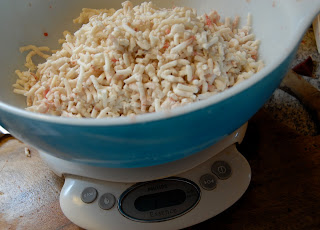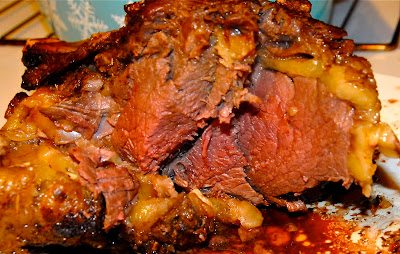Stampede.
I've noticed a growing feeling of unease coming over me as of late. My consumption of paleo blogs and information sources has waned. My antennae have been perked in the general direction of overzealousness in this paleo world and I don't like what I'm seeing.
I've heard
Robb Wolf talk about his discomfort with the direction of turning a paleo way of approaching nutrition into a card carrying, cult like movement where we all sit around discussing whether or not something is or is not paleo. He mentioned his desire for us to continue to challenge and question what we learn. I'm completely on board with his insights.
I was a vegetarian many moons ago, then, when I started to face the
consequences of my nutritionally inadequate diet, I did what any sane vegetarian would do, I restricted my food even more and became a vegan. You can probably guess how that turned out. I was a sick, sick girl. When I started to consume animal products again, they had to be from sources that I knew so I could ensure that the meat I was eating was raised ethically and on healthy pastures. From there, I learned about the
Weston A. Price Foundation and started swirling around in those circles, but the grains and legumes didn't sit well with me so I moved on. In everything I've experienced, I've walked away with knowledge and confidence in my decisions. By not getting entrenched in an ironclad position, I've been able to increase my family's health and understanding of what it means to eat and live well.

No matter how I was eating, I noticed a trend for people to become fanatical about they ate and what they thought other people should eat. I don't like this inclination we humans have of falling into groups that can be labelled. Call me a nonconformist, but as soon as I hear collective voices espousing rules as doctrine, my back goes up. I seem to be sniffing this out a lot lately. Whether it's the vegetarians, vegans, macrobiotic followers, the Weston A. Price clan, and now the paleo/primal group, people tend to fall in line behind the label and stop thinking for themselves. We find our clan and then blindly follow along, closing off our minds and ignoring our intuition. I don't know if it's because I'm getting older or just that I have enough life experience to know that I'm simply not willing to go that route no matter how much I may dig the philosophy.

These native prairie grasses are some of the less than 5% left in the world. This is where my farmers raise their animals. What are your animals raised on?
I'm starting to resist calling the way I eat "paleo" or "primal" simply because I think it gives people the wrong idea. I don't care for a snappy label and I don't care to create soundbites that can explain how I eat in one minute or less. First, I don't think people really care how I eat. For the few that are genuinely interested, I want to get across the importance of them finding good farmers that are producing food that was nourished on healthy soils, farmers who are striving to still produce food, not just commodities. To me, that's more important than chiming off the 'good' and 'evil' list of foods. O.k., maybe I try and sneak in a quick sentence of two on the problem with grains and sugar as well, but there's a bigger picture here.
I was reading a blog the other day discussing why coconut oil is a better choice over
home rendered lard for cooking. "Coconut oil has more saturated fat", was the reason given for its nutritional superiority. But there's so much missing from this picture. That coconut oil has to be shipped from thousands of miles away. That coconut oil varies wildly in quality. That coconut oil can never, ever, be produced by me or my farmers. Don't get me wrong, I like coconut oil, but there seems to be something missing from this equation.
When I buy a whole, heritage breed pig, raised on tubers, roots, and grass, from my local farmer, I am using that whole animal. There is no waste. That fat is rendered down and used to create lard. Are there not nutrients and energy and things unmeasurable in the consumption of such food? Science is a useful tool when making decisions, but we can't lose site of the power of our intuition and our common sense. We've evolved as a species to rely on multi-sensory information. We devalue ourselves when we limit our choices based on only a mechanistic, scientific viewpoint.
The bison in our freezer? I rendered down the tallow from that animal who spent its life in the sun, eating grass. Those jars of deep yellow fat come from that animal's ability to harness the energy and nutrition from the prairies it roamed on. How do I measure that? How do I quantify the nutrition in that jar? We could talk about vitamins
A, D, and K. We could talk about CLA and omega 3s. What else can we measure? More importantly, what about the all the stuff we can't measure at all?
Isn't this reductionist thinking, the oversimplification of macro and micro nutrients, determining the worth of something by measuring it against a standard of compliance to a certain diet doctrine, what we're trying to get away from?
I'm not willing to carry the paleo placard in lieu of common sense. No, we don't eat grains, legumes, or sugar. Yes, we eat plenty of grass fed meats, saturated fats, and fermented foods. But, so what? I'm not going to Trader Joes, picking up a pack of "free range" eggs and a jar of coconut oil and smugly walking out, feeling like I'm doing my part for the paleo party. We need to be connected to our food, to our farmers, to our land, and to ourselves in order to really understand how our ancestors walked this earth. That's the only way we can make a difference of significance.




































